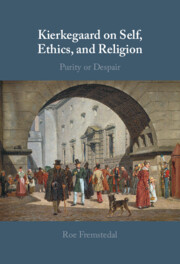Book contents
- Kierkegaard on Self, Ethics, and Religion
- Kierkegaard on Self, Ethics, and Religion
- Copyright page
- Dedication
- Contents
- Figures and Tables
- Acknowledgments
- Abbreviations
- Introduction
- Part I Self, Despair, and Wholeheartedness
- Part II Morality, Prudence, and Religion
- Chapter 4 The Critique of Eudaimonism: Virtue Ethics, Kantianism, and Beyond
- Chapter 5 Noneudaimonistic Ethics and Religion: Happiness and Salvation
- Chapter 6 The “Teleological Suspension of the Ethical” and Abraham’s Sacrifice of Isaac
- Chapter 7 Moralized Religion: The Identity of the Good and the Divine
- Part III “Subjectivity, Inwardness, Is Truth”
- Part IV Faith and Reason
- References
- Index
Chapter 5 - Noneudaimonistic Ethics and Religion: Happiness and Salvation
from Part II - Morality, Prudence, and Religion
Published online by Cambridge University Press: 27 January 2022
- Kierkegaard on Self, Ethics, and Religion
- Kierkegaard on Self, Ethics, and Religion
- Copyright page
- Dedication
- Contents
- Figures and Tables
- Acknowledgments
- Abbreviations
- Introduction
- Part I Self, Despair, and Wholeheartedness
- Part II Morality, Prudence, and Religion
- Chapter 4 The Critique of Eudaimonism: Virtue Ethics, Kantianism, and Beyond
- Chapter 5 Noneudaimonistic Ethics and Religion: Happiness and Salvation
- Chapter 6 The “Teleological Suspension of the Ethical” and Abraham’s Sacrifice of Isaac
- Chapter 7 Moralized Religion: The Identity of the Good and the Divine
- Part III “Subjectivity, Inwardness, Is Truth”
- Part IV Faith and Reason
- References
- Index
Summary
Chapter 5 shows that Kierkegaard does not reject prudence or self-interest as antieudaimonism tends to do. Instead, he develops a noneudaimonistic ethics and theology, in which morality overrides prudence in cases of conflict. Still, his concept of the highest good (eternal happiness) involves a synthesis of morality and prudence, in which happiness is conditioned by morality. Like Kant, Kierkegaard develops a noneudaimonistic “highest good” and rejects both predestination and Pelagianism, sketching an intermediary view that combines human agency with divine grace. However, he departs from Kant by combining a modern account of alterity, in which morality is essentially other-regarding, with the idea that morality is Christocentric, since it concerns imitating Christ and serving the neighbor. The result is an account of morality and happiness which is not only broadly Augustinian and Kantian but also highly modern.
- Type
- Chapter
- Information
- Kierkegaard on Self, Ethics, and ReligionPurity or Despair, pp. 93 - 104Publisher: Cambridge University PressPrint publication year: 2022

